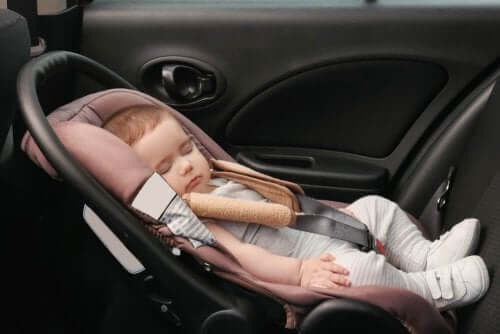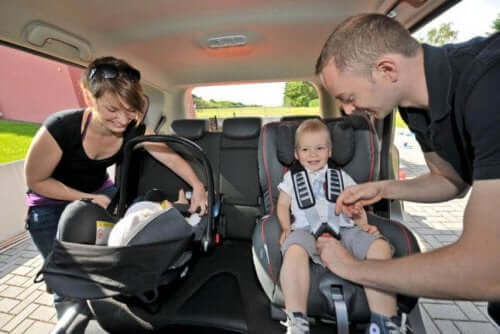Regulations Regarding Child Car Seats

Regulations regarding child car seats have undergone many changes in recent years. It’s important to remember that all of these changes have one single purpose. Car seat regulations serve to guarantee greater safety to children while traveling by car.
It’s important to remember that the main cause of death in children under the age of 14 is traffic accidents. And retention systems, such as adult seat belts and infant car seats, help to significantly reduce death rates and serious injury.
Therefore, complying with infant car seat regulations isn’t about avoiding fines or other penalties. It’s about saving the life of your child. Below, we’ll look at several elements in order to understand current regulations.
The most common types of injury
The injuries that children can suffer as the result of a car accident are very serious. Up until the age of two, the most frequent accidents involve the neck. This is due to the size of infants’ heads and the fragility of their spinal columns.
In children between the ages of two and four, the most common injuries involve the head. This occurs because the vertebra in the neck aren’t strong enough yet to resist sudden deceleration.

As for children between the ages of four and ten, the most frequent injuries occur in the abdomen. At this point, their organs still aren’t completely attached to the abdominal structure. Therefore, children have a higher risk of suffering internal hemorrhages or abdominal injuries.
The correct use of car seats and child retention systems in general reduces death rates by 75% and injury by 90% in the case of an accident. Regulations also apply to the type of retention system each child should use. This is determined by age, height and weight.
Regulations regarding child car seats
All child car seats should be certified and carry a label that guarantees their compliance with all state car seat regulations. If you’re traveling in other states, you should make sure that your child’s retention system meets those requirements as well.
Make sure that you choose a suitable car seat and that you’re aware of when you need to change it. All children who are younger than 8 and shorter than 4 feet, 9 inches must also use a retention system. This system should be adapted to his or her weight and height, and always be in the back seat of the car.
Children should never sit on someone’s lap while traveling, for any reason whatsoever. Nor should they use an adult car seat.
A different car seat for each group
Retentions systems divide children into 4 different groups. The first group includes newborns and babies up to 30 lbs in weight. These seats should always be rear-facing, located in the back seat of the car. This position offers better protection to the head. Furthermore, the seat should contain a 5-point harness.
The second group includes children who weigh between 20 and 40 pounds. The correct seat for this group should be installed with either a seat belt or via Isofix. Installing the car seat according to the specific factory instructions is fundamental.
You should never sit your child in a car seat without first installing it correctly and making sure it’s stable. Finally, secure your child to the seat with a 5-point harness.

The third group includes children weighing between 33 and 80 lbs, and consists of booster seats. Children who require booster seats are too big for car seats, but still too small to use an adult seat belt.
The purpose of these booster seats is to raise the height of children so that they can use car seat belts in a safe way. Booster seats with back support are the best choice, as they provide added security. They protect the upper lumbar region and the necks of children.
Finally, children who are taller than 4 feet, 9 inches can use seat belts without the need for a retention system.
Remember that these are general guidelines. Before choosing a retention system for your child, be sure to review local laws and check for any change in regulations. Also, as one final safety recommendation, remember that children should never wear winter jackets while riding in a car seat.
Regulations regarding child car seats have undergone many changes in recent years. It’s important to remember that all of these changes have one single purpose. Car seat regulations serve to guarantee greater safety to children while traveling by car.
It’s important to remember that the main cause of death in children under the age of 14 is traffic accidents. And retention systems, such as adult seat belts and infant car seats, help to significantly reduce death rates and serious injury.
Therefore, complying with infant car seat regulations isn’t about avoiding fines or other penalties. It’s about saving the life of your child. Below, we’ll look at several elements in order to understand current regulations.
The most common types of injury
The injuries that children can suffer as the result of a car accident are very serious. Up until the age of two, the most frequent accidents involve the neck. This is due to the size of infants’ heads and the fragility of their spinal columns.
In children between the ages of two and four, the most common injuries involve the head. This occurs because the vertebra in the neck aren’t strong enough yet to resist sudden deceleration.

As for children between the ages of four and ten, the most frequent injuries occur in the abdomen. At this point, their organs still aren’t completely attached to the abdominal structure. Therefore, children have a higher risk of suffering internal hemorrhages or abdominal injuries.
The correct use of car seats and child retention systems in general reduces death rates by 75% and injury by 90% in the case of an accident. Regulations also apply to the type of retention system each child should use. This is determined by age, height and weight.
Regulations regarding child car seats
All child car seats should be certified and carry a label that guarantees their compliance with all state car seat regulations. If you’re traveling in other states, you should make sure that your child’s retention system meets those requirements as well.
Make sure that you choose a suitable car seat and that you’re aware of when you need to change it. All children who are younger than 8 and shorter than 4 feet, 9 inches must also use a retention system. This system should be adapted to his or her weight and height, and always be in the back seat of the car.
Children should never sit on someone’s lap while traveling, for any reason whatsoever. Nor should they use an adult car seat.
A different car seat for each group
Retentions systems divide children into 4 different groups. The first group includes newborns and babies up to 30 lbs in weight. These seats should always be rear-facing, located in the back seat of the car. This position offers better protection to the head. Furthermore, the seat should contain a 5-point harness.
The second group includes children who weigh between 20 and 40 pounds. The correct seat for this group should be installed with either a seat belt or via Isofix. Installing the car seat according to the specific factory instructions is fundamental.
You should never sit your child in a car seat without first installing it correctly and making sure it’s stable. Finally, secure your child to the seat with a 5-point harness.

The third group includes children weighing between 33 and 80 lbs, and consists of booster seats. Children who require booster seats are too big for car seats, but still too small to use an adult seat belt.
The purpose of these booster seats is to raise the height of children so that they can use car seat belts in a safe way. Booster seats with back support are the best choice, as they provide added security. They protect the upper lumbar region and the necks of children.
Finally, children who are taller than 4 feet, 9 inches can use seat belts without the need for a retention system.
Remember that these are general guidelines. Before choosing a retention system for your child, be sure to review local laws and check for any change in regulations. Also, as one final safety recommendation, remember that children should never wear winter jackets while riding in a car seat.
All cited sources were thoroughly reviewed by our team to ensure their quality, reliability, currency, and validity. The bibliography of this article was considered reliable and of academic or scientific accuracy.
- sillasdecoche.fundacionmapfre. Partes importantes de una silla infantil. Extraído de: https://sillasdecoche.fundacionmapfre.org/infantiles/images/partes-fundamentales-silla_tcm725-151603.pdf
- Dirección General Tráfico. (2015). Sistemas de retención infantil. Extraído de: http://www.dgt.es/Galerias/seguridad-vial/educacion-vial/recursos-didacticos/infancia/2015/Sistemas-de-Retencion-Infantil-DGT.pdf
This text is provided for informational purposes only and does not replace consultation with a professional. If in doubt, consult your specialist.








